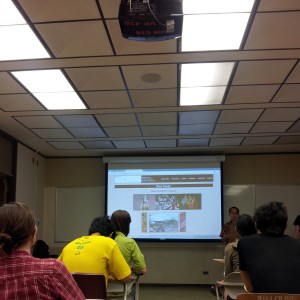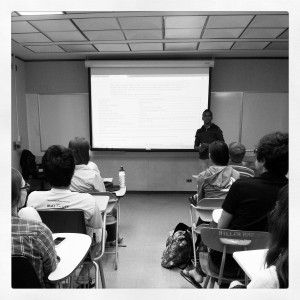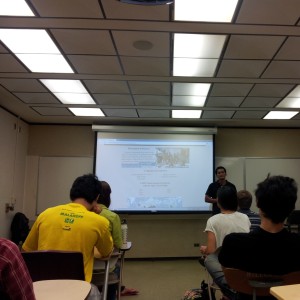I ka olelo no ke ola, i ka olelo no ka make. Life is in speech; death in speech. This is a famed olelo noeau expression (wise-saying) in the Hawaiian language widely used to describe the power of language to heal, destroy (Source: Pukui, 1983). When examining deeper: language carries the customs, cultures, and traditions of a people…if that goes, everything (in theory) else gives way (in other words, the foundation is unstable). But, it doesn’t mean that language can’t make a come back!
Recently, I attended a final presentation from participants of the Language Documentation Training Center (LDTC) program at the University of Hawaii at Manoa. The program started 10 years ago and is led by graduate students in the linguistics department. It reminds me of another expression penned by Tutu Mary Kawena Pukui “I ka moana no ka ia, liuliu ia no pono lawaia. While the fish is still in the sea, get your gear ready.” The purpose and intent of the program is to document endangered world languages.
Many of the students that participate in the LDTC are international students from the East-West Center. Collectively, everyone has value. It’s really cool to look within our own EWC family and listen to them share their stories and oral narratives of their websites describing their native tongues. On this night we had: Irma of Indonesia, Sandrine of Vanuatu, Leo of East-Timor, Dev of Niue, and Philip of Papua New Guinea. Here’s some glimpses of their story:
Deveraux Talagi is from Niue, a 260-square-mile island country in the South Pacific that forms a triangle with Tonga (to the west), Samoa (to the North), and the Cook Islands (to the East). He presents his website on the language of Niue: Vahagau Niue (Niuean). He is very excited about the project as a means to connect to home and promote language documentation and revitalization as Vahagau Niue is a critically endangered language. Learn more at: http://www.ling.hawaii.edu/ldtc/languages/niuean/
 Irma Nurhikmah is from Indonesia. Her husband presented on her behalf her native tongue of Basa Sunda (Sundanese). Irma and their husband are very excited to apply what they learn back home and further document, and promote language revitalization. Check out their website at: http://www.ling.hawaii.edu/ldtc/languages/sundanese_irma/
Irma Nurhikmah is from Indonesia. Her husband presented on her behalf her native tongue of Basa Sunda (Sundanese). Irma and their husband are very excited to apply what they learn back home and further document, and promote language revitalization. Check out their website at: http://www.ling.hawaii.edu/ldtc/languages/sundanese_irma/
 Kamano Kafe language, one of 800 plus languages of Papua New Guinea. Philip, a master’s student in Plant and Tropical Science and EWC fellow, is sharing his language to the LDTC program. The Kamano language is a critically endangered language because of globalisation. The picture of him on his website was taken 2 years ago before he came to study at the University of Hawaii at Manoa. He wished he could have wore his traditional wear that night. Learn more about his native tongue: http://www.ling.hawaii.edu/ldtc/languages/kamanokafe/
Kamano Kafe language, one of 800 plus languages of Papua New Guinea. Philip, a master’s student in Plant and Tropical Science and EWC fellow, is sharing his language to the LDTC program. The Kamano language is a critically endangered language because of globalisation. The picture of him on his website was taken 2 years ago before he came to study at the University of Hawaii at Manoa. He wished he could have wore his traditional wear that night. Learn more about his native tongue: http://www.ling.hawaii.edu/ldtc/languages/kamanokafe/
 Sandrine, a graduating senior in Biology this semester, speaks to linguistic genocide and her desire to document one of the five languages she speaks. She is sharing the #naleh language of NorthWest Malekula, Vanuatu. Her people are known as the last cannibals of Vanuatu. She shared a song to us that was about water which is a major natural resource. The song describes the relationship between people, their water, and natural environment. She is excited to document her language after gaining a renewed sense of pride for the uniqueness of the Naleh language and the need to keep it going for future generations…. Learn more about Naleh language at: http://www.ling.hawaii.edu/ldtc/languages/naleh/
Sandrine, a graduating senior in Biology this semester, speaks to linguistic genocide and her desire to document one of the five languages she speaks. She is sharing the #naleh language of NorthWest Malekula, Vanuatu. Her people are known as the last cannibals of Vanuatu. She shared a song to us that was about water which is a major natural resource. The song describes the relationship between people, their water, and natural environment. She is excited to document her language after gaining a renewed sense of pride for the uniqueness of the Naleh language and the need to keep it going for future generations…. Learn more about Naleh language at: http://www.ling.hawaii.edu/ldtc/languages/naleh/
 Leo of East Timor (Timor-Leste) speaks Tetun (Portuguese Version) and Tetun-Prasa. He’s excited to revitalize his language after learning from what happened to Hawaii. The song Leo shared was written by his friend and Leo played the guitar in the background. The song speaks to East Timor independence that was gained 22 years ago from Indonesia. He mentioned that he will contribute to language revitalization through himself first. In his homeland, they use the US dollar as currency. When they count bills from 1 to 100, they count in Indonesian. When they count change, they speak in English. He has committed to speaking his native tongue when counting money, and will share this with his friends and family. This is inspiring! Read more about his language at: http://www.ling.hawaii.edu/ldtc/languages/tetun_leogtdsr/
Leo of East Timor (Timor-Leste) speaks Tetun (Portuguese Version) and Tetun-Prasa. He’s excited to revitalize his language after learning from what happened to Hawaii. The song Leo shared was written by his friend and Leo played the guitar in the background. The song speaks to East Timor independence that was gained 22 years ago from Indonesia. He mentioned that he will contribute to language revitalization through himself first. In his homeland, they use the US dollar as currency. When they count bills from 1 to 100, they count in Indonesian. When they count change, they speak in English. He has committed to speaking his native tongue when counting money, and will share this with his friends and family. This is inspiring! Read more about his language at: http://www.ling.hawaii.edu/ldtc/languages/tetun_leogtdsr/
My overall impression of the Language Documentation Training Center Program is that they are doing amazing work in documenting endangered languages. LDTC also gives the participants tools to not only document but stimulate language revitalization. I am motivated to continue my Hawaiian language practicing and am encouraged by the many steps in making languages thrive and be perpetuated. I encourage everyone who speaks an endangered language to join the program, and begin to take steps to document the language (and/or dialect). I also encourage those from cultures with endangered languages to continue to speak it, and/or make efforts to achieve and maintain fluency. It is known that our languages provides a lens and window to another dimension, another diverse worldview that is valuable for not only the present but also for future generations but also connects and roots us to our ancestors.
To learn more about the Language Documentation Training Center Program, check out their website: http://www.ling.hawaii.edu/ldtc/languages.html

